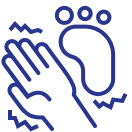
Overview
Castleman disease is a group of rare disorders characterized by lymph node enlargement, specific microscopic changes to the lymph nodes, and a range of symptoms and laboratory findings.
Castleman disease has a broad spectrum of disease severity, ranging from mild compressive symptoms and fatigue to life-threatening multi-organ failure. Symptoms of Castleman disease often overlap with symptoms of other more common illnesses which makes diagnosis difficult. A Castleman disease diagnosis can only be made with a lymph node biopsy that shows characteristic Castleman disease features and when all other illnesses have been evaluated and excluded.

Symptoms of unicentric Castleman disease (UCD)
In unicentric Castleman disease (UCD), enlarged lymph nodes appear in only one region of the body.
- UCD symptoms tend to be mild and occur secondary to compression of surrounding structures by rapidly enlarging lymph nodes.
- Less commonly, some UCD patients can experience systemic inflammatory symptoms such as fatigue and laboratory abnormalities such as low hemoglobin and elevated C-reactive protein.
Symptoms of multicentric Castleman disease (MCD)
In multicentric Castleman disease (MCD), enlarged lymph nodes appear in multiple regions of the body. Symptoms occur due to a systemic hyperinflammatory response an tend to be more severe than UCD symptoms








